#southern sable antelope
Text
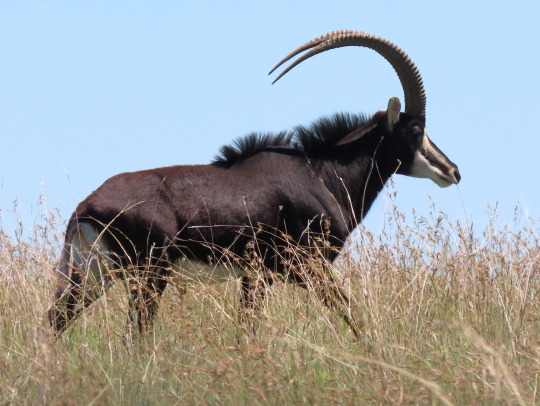
Southern sable antelope Hippotragus niger niger
Observed by gigilaidler, CC BY-NC
472 notes
·
View notes
Text
Animal of the Day!
Bluebuck (Hippotragus leucophaeus)

(Photo in Public Domain)
Extinction Date- 1800
Habitat- Southern Africa
Size (Weight/Length)- 200 kg; 1.6 m
Diet- Grasses
Cool Facts- By the time the bluebuck was scientifically described, it was already on the decline and the Europeans certainly didn’t help. Bluebucks lived in small herds and spent their lives on the move in search of fresh grasses. These antelope are considered the first large African mammal to go extinct in modern times. Changes in environment, such as a rising sea level, and low genetic diversity already put the bluebuck at risk. Europeans then hunted the antelope to extinction for its meat and as museum specimens. Multiple rock paintings depict Bluebuck throughout Africa and were believed to have supernatural potency by Neolithic peoples. Roan and sable antelopes, their closest relatives, still wander Africa today. Sable antelope are critically endangered due to illegal hunting and conservations are rushing to make sure it doesn’t go the way of the bluebuck.
Rating- 13/10 (Only remembered by four taxidermied individuals.)
#animal of the day#animals#mammals#antelope#monday#october 2#bluebuck#biology#science#conservation#the more you know#taxidermy#extinct#extinctober#roan antelope#sable antelope
157 notes
·
View notes
Text
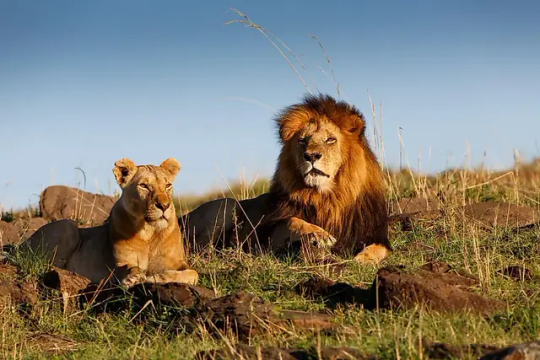



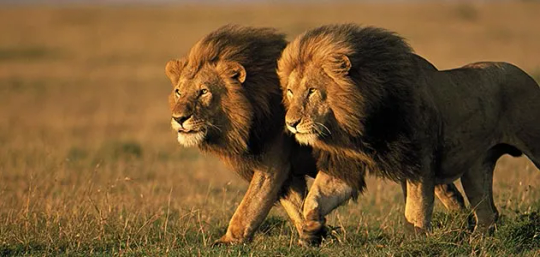
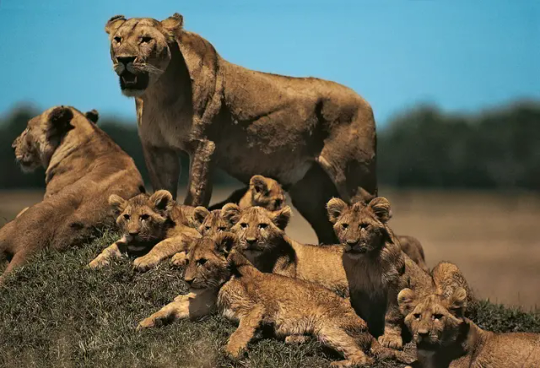



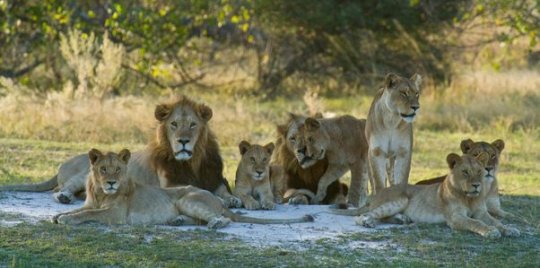
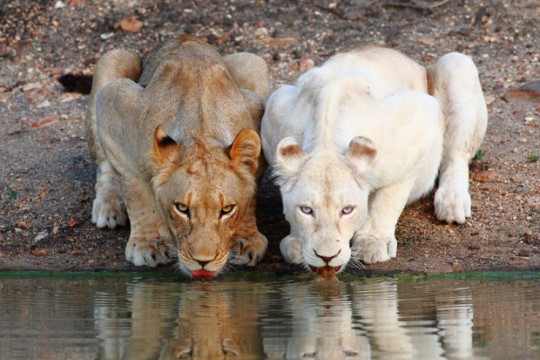
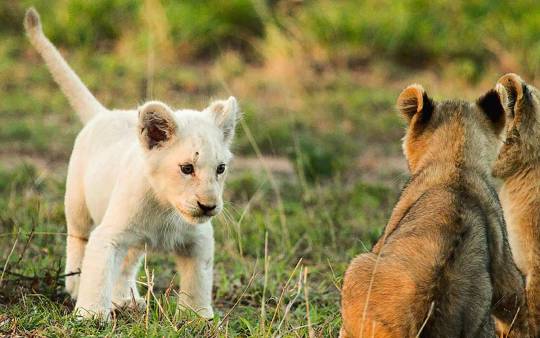
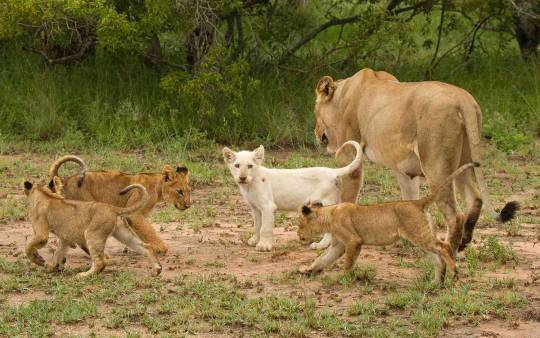
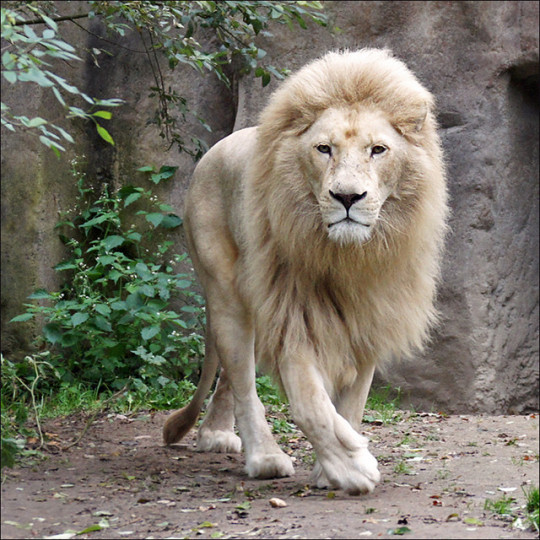
Panthera leo melanochaita better known as the east African lion, the Southern lion, the Southern African lion, or the East-Southern African lion,, is a subspecies of lion native to eastern and southern Africa. Here they prefer to inhabit grasslands and savannas, but are also known to inhabit open woodland, scrublands, and montane forests. African lions are the most social of all wild felines, living in groups of related individuals and their offspring called prides which number 3 to 30 females and 1 to 4 males. East African lions typically prey upon ungulates such as wildebeest, cape buffalo, eland, gemsbok, nyala, roan and sable antelope, warthogs, bush pigs, zebra, tsessebe, waterbuck, kudu, hartebeest, kob, and thomson’s gazelle, however they are also known to hunt other prey from as small as common mice to as large as young or infirm African bush elephants. Lions are themselves occasionally killed by other predators such as wild dogs, hyenas, leopards, other lions, and crocodiles. Female east African lions average around 7.5 to 8.9ft (2.3 to 2.7m) in length, and 183 to 370lbs (83 to 168kgs) in weight while males average around 8.1 to 9.4ft (2.47 to 2.84m) in length and 321 to 496lbs (145 to 225kgs) in weight, however lions as big as 11ft (3.35m) and 825lbs (375kgs) have been known to exist. This marks the lion as the second largest extant cat after the tiger. The lion is a muscular, broad-chested cat with a short, rounded head, a reduced neck, and round ears. The fur varies in color from light buff to silvery grey, yellowish red, and dark brown, additionally albino and leucistic individuals are not unheard of. Mature males typically sport long flowing manes, but may occasionally lack them. Additionally females may occasionally grown manes as well. Breeding may occur year round, with each mature female having there own estrous cycle. When in heat she will breed with one or more partners. After a 110 day pregnancy a mother lion will give birth to 1 to 4 cubs in a secluded den away from the rest of the pride. She will not rejoin the pride until her young are around 6 to 8 weeks of age. East African Lions reach maturity around 2 to 4 years of age, at which point the males are typically forcibly evicted from the pride and females may choose to set of in search of another to join. Under ideal conditions an east African lion may live up to 18 years.
#pleistocene pride#pleistocene#pliestocene pride#pliestocene#cenozoic#ice age#stone age#mammal#lion#africa#african lion#east african lion#white lion#cub#lioness#cat#big cats#feline
31 notes
·
View notes
Text

[ The specimen in question, the horns and partial skull of a bluebuck. ]
"The bluebuck or blue antelope was the first large African mammal to go extinct in recent times.
Once found living in the grasslands along the southern coast of South Africa, it was driven to extinction by humans in around 1800. While closely related to two surviving antelopes, the sable and roan, the bluebuck was distinct having split from a last common ancestor some 1.5 million years ago.
As the name suggests, the bluebuck had a predominantly blue-grey coat that faded to a whitish colour on its belly. On its head it had white patches in front of its eyes, and a pair of large, ridged horns that swept back in an elegant curve. While these horns were typically smaller than those found on its relatives, they still reached a respectable length of about 50 centimetres.
But the likely scarcity of the bluebuck by the time Europeans first encountered it, and the speed at which it was made extinct, means that there are astonishingly few specimens of this antelope in museums around the world. Now a new study has used genetics to confirm that a pair of horns in the Natural History Museum’s collection is from the unfortunate species, bringing the total number of confirmed bluebuck specimens globally to five."
- Excerpt from "Horns in the Natural History Museum's collection confirmed to be from extinct bluebuck antelope" by Josh Davis.
25 notes
·
View notes
Text
Fascinating Facts About the Black Lechwe Antelope
The black lechwe is a small antelope found in southern Africa. It is often considered a subspecies of the greater sable antelope.
About
The black lechwe is a medium-sized antelope with a unique appearance. It reaches an average height of about 1 meter (3.3 feet), weighing 60 to 128 kilograms (132 to 282 pounds). Although it normally moves at a leisurely pace, it possesses remarkable swimming capabilities and can often be seen grazing in aquatic areas up to its chest level - almost like submarines!
Its oily coats serve as both waterproofing agents; while simultaneously providing offbeat aroma characterizing this species. While males do exhibit antlers, they are only sometimes observed among the herd since most maturing members are solitary creatures that remain in groups during much of the year.
What Is A Lechwe?
A lechwe is an antelope native to Africa, more specifically the wetter areas of southern Africa. It is a member of the genus Kobus, which includes other antelopes such as the kob, waterbuck, and puku. The lechwe is easily identified by its reddish-brown coat and long, curved horns.
Its chest and rump are white, and its legs are covered with a black mane. Its face is marked with a white line that runs from the eyes to the nose. The lechwe is an excellent swimmer and can even cross flooded areas due to its long legs and webbed hooves. It mainly feeds on aquatic grasses and sedges, but will also eat leaves, fruits, and buds when available.
The lechwe is a social animal that lives in herds of up to 100 individuals led by a dominant male. Although it is a shy animal, it can become aggressive when threatened or when defending its territory. The lechwe is currently listed as "Near Threatened" by the IUCN due to its decreasing population size caused by poaching and habitat loss.
Where Does The Black Lechwe Live?

The black lechwe is an antelope native to Africa, specifically the wetlands of Zambia, Angola, Botswana, and Namibia. It is a medium-sized species of antelope and is easily recognizable by its unique coloring and the male's large horns.
This antelope inhabits a variety of wetland habitats, including floodplains, swamps, marshes, and seasonally flooded grasslands. While black lechwes prefer wetland ecosystems, they can also be found in areas of open woodland and grassland.
In Zambia, they are most commonly found in the Bangweulu Wetlands and along the Luapula River. In Angola, they are primarily located in the Okavango Delta and along the Cuando River. Meanwhile, in Botswana they inhabit the Okavango Delta and the Makgadikgadi Pans National Park. Finally, in Namibia they are primarily located in Etosha National Park.
What Is The Diet Of A Black Lechwe Antelope?
The Black Lechwe Antelope is a herbivore native to Africa's wetlands. It is particularly well adapted for its wetland environment and is an essential part of the food chain. The Lechwe Antelope's diet consists mainly of grasses, aquatic plants, and sedges.
Because Lechwe Antelopes are grazers, they will often spend hours grazing and foraging for food. During the wet season, they can eat up to seven kilograms of food a day! During the dry season, they feed on reeds, sedges, and other aquatic vegetation.
The Lechwe Antelope also consumes fruits, seeds, and roots when available. It is an opportunistic feeder and will eat almost anything it finds in its habitat. As a result of their diet, the Lechwe Antelope is able to survive in both wet and dry environments. This adaptability makes them an important part of their ecosystem, as they help maintain the balance of the environment.
How Do Black Lechwe Antelope Reproduce?
Males and females reach sexual maturity at around 18 months of age. The mating season takes place from May to July, and black lechwe usually gives birth to one or two calves after a gestation period of around nine months.
Why Are Black Lechwe Antelope Vulnerable?
Black lechwe is considered a vulnerable species due to their declining population numbers. Factors that have contributed to this decline include habitat loss, poaching, and disease.
However, there is hope that they can be saved if proper conservation measures are taken.
How Big Is A Black Lechwe?
The black lechwe is an antelope found mainly in south-central Africa. It is an impressive animal, with a body length of up to 4.5 feet long and a shoulder height of up to 3 feet. The males tend to be considerably larger than the females, weighing up to 130 pounds compared to the females' maximum weight of 95 pounds.
In addition to their impressive size, the black lechwe is known for its impressive speed and agility. They can reach top speeds of 40 miles per hour and can turn quickly on their hooves. With their keen sense of smell and hearing, they are able to detect any potential danger and escape it quickly.
As a result, the lechwe has become a symbol of strength and speed in many African cultures. So if you ever find yourself wondering "How big is a black lechwe?", you can rest assured that they are an impressive creature indeed!
What is The Physical Description Of Black Lechwe Antelope?
Black lechwe is one of the most strikingly beautiful antelope species. They have a reddish-brown coat with black markings, and their long legs are covered in white hair. They also have distinctive black horns that curve backward.
How Long Does A Black Lechwe Antelope Live?
They are an important part of the ecosystem, and it is important to understand how long they can live. On average, the black lechwe antelope lives for up to 12 years in the wild. However, in captivity, if provided with the correct diet and living conditions, they can live for up to 20 years.
What Kind Of Habitat Do Black Lechwe Antelope Prefer?
Black lechwe is well-adapted to aquatic environments and can be found in marshes, swamps, and floodplains.
They prefer areas with plenty of dense vegetation where they can hide from predators.
Black Lechwe Antelope Communication And Perception
Black lechwe communicates with each other using a variety of vocalizations, including grunts, barks, and whistles.
They are also very sensitive to movement and can detect predators from long distances. This helps them stay safe while they're grazing in open areas.
What is the Black Lechwe Antelope Role İn The Ecosystem?
Black lechwe is an important part of their ecosystem and plays a crucial role in the distribution of nutrients.
They also help to keep vegetation trimmed down, which helps improve the habitat for other species.
Black Lechwe Antelope Conservation Status
The lechwe is considered a vulnerable species due to their declining population numbers. Factors that have contributed to this decline include habitat loss, poaching, and disease.
How Many Black Lechwe Antelope Are Left İn The World?
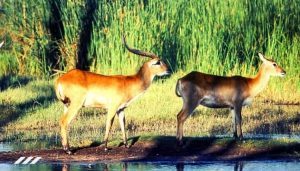
How Many Black Lechwe Antelope Are Left İn The World??
There are currently estimated to be between 30,000 and 40,000 black lechwe antelope remaining in the world. This number is declining every year, so steps must be taken to protect them.
Black Lechwe Antelope Anti-predator Adaptation
One of the most impressive adaptations black lechwe have is their ability to swim. They can cross wide rivers and swamps, which helps them avoid predators. They are also very fast runners and can outrun most predators.
Where Do Black Lechwe Antelope Sleep?
Black lechwe antelope sleep in herds and typically bed down in tall grass or reeds near water. They usually only sleep for a few hours at a time, so they can be constantly on the lookout for predators.
Red Lechwe Antelope: One of the Most Eye-catching Animals in Africa
What Plants Do Black Lechwe Antelope Avoid?
Black lechwe antelope are very selective in what they eat, and will only eat plants that are safe to consume. They avoid eating poisonous plants, which helps keep them from getting sick.
So there you have it! We hope you've enjoyed learning about these amazing animals. Be sure to share this post with your friends and family, and let us know what you think in the comments section below. Thanks for reading! :)
- A Rare Visayan Spotted Deer Population In The Philippines
- The Lelwel Hartebeest Antelope: An Amazing Animal
- Endangered Species: Tora Hartebeest Antelope
- The Western Hartebeest Antelope (alcelaphus Buselaphus Major)
- African Hartebeest Antelope: Unique Facts About an Interesting Animal
Conclusion
The black lechwe is a small antelope found in southern Africa. It is often considered a subspecies of the greater sable antelope.
References: Lechwe
What Predators Do Black Lechwe Antelope Have?
Lions, leopards, hyenas, and crocodiles are all predators of black lechwe. They are also preyed upon by eagles and hawks.
Can Black Lechwe Antelope Swim?
Black lechwe antelope are very good swimmers and can swim across wide rivers and swamps. This helps them avoid predators and get to food sources that other antelope species cannot reach.
İs Black Lechwe Antelope Aggressive?
Black lechwe is not typically aggressive, but they will defend themselves if threatened. They can also be territorial when it comes to their food sources.
How High Can Black Lechwe Antelope Jump??
Black lechwe can jump up to six feet high, which helps them escape predators. They can also use their powerful legs to kick predators away.
Read the full article
0 notes
Text
The Ultimate Secret Ruaha National Park
Ruaha national park is one of the few Tanzania’s famous wilderness area where one can have a rare experience of game viewing spiced up by the fascinating landscape. The park is rich of plants and animals such as Greater Kudu (Tragelaphus strepsiceros) which can not be found in any other national park. The park boasts of her almost untouched and unexplored ecosystem, making visitors’ safari experience very unique.
The Great Ruaha River as other rivers like Mwagusi, Jongomero and Mzombe save as the life line of the park. During dry season, these rivers become mostly the main source of water for wildlife. There are few natural springs saving the same purpose.
In the pick of dry season, elephants obtain water from dry sand rivers using their front feet and trunks. The remaining water falls along the Great Ruaha River are also important habitat for hippopotamus, fish and crocodiles.
CLIMATE
Ruaha National Park has a bimodal pattern of rain forest; the short rainfall season begins November to February, while the long season is between March and April. The annual mean rainfall ranges between 500mm-800mm with the average annual temperature of about 280c. The park experiences its dry season between June and October when the temperature at Msembe headquarter reaches 350c.
PARK HISTORY
The park history dates back to 1910 when it was gazetted Saba Game Reserve by the Germany then the name was changed by British to Rungwa Game reseve in 1946. In 1964 the southern portion of the Game was gazetted as Ruaha national park and in 1974 a small section of South Eastern part of the Great Ruaha River was incorporated into the park. The name “Ruaha” originates from the Hehe word “Ruvaha”, which means “river”. Ruaha National Park is part of Rungwa-Kizigo –Muhesi ecosystem which covers more than 45000km2. In 2008 Usangu game Reserve and other important wetlands in Usangu basin have been annexed into the park, making it the largest park in Tanzania and East Africa with an area of about 20226km2.
PARKS SIGNIFICANCE
Ruaha National Park has a high diversity of plants and animals including elephants, buffalos, antelopes and some of rare and endangered species like wild dogs. The park serves as water shade both for wildlife and human being. This makes it to be economically significant as it supports agricultural activities down stream and contributes to hydro- electric power (HEP) for the country at Mtera and Kidatu dams.
TOURISM ATTRACTIONS
Birds
The park is one of the Tanzania birds’ paradise with more than 571species and some of them are known to be migrants from within and outside Africa. Migrating species from Europe, Asia, Australian rim and Madagascar have been recorded in the park. Species of interest in the park include Ruaha red-billed hornbill (Tokus ruahae) which is dominant in the area. The recently annexed wetland, the Usangu basin is one of the country’s important bird area (IBA) as recognized by Birdlife International. Though birds can be seen all the year around, the best time for bird watching is during the wet season.
Animals
Ruaha is believed to have high concentration of elephants than any national park in East Africa. It is also a place where, magnificent mammals like Kudu (both Greater and Lesser), Sable and Roan antelopes can easily be spotted in Miombo woodland. The male Kudu have beautiful spiraled horns while male Sable antelope have impressive curved horns. The park is also a habitat for endangered wild dogs. Other animals in the park include lions, leopards, cheetah, giraffes, zebras, elands, impala, bat eared foxes and Jackals.
Reptiles and Amphibians
Apart from large animals, the park also harbors a number of reptiles and amphibians such as crocodiles, poisonous and non-poisonous snakes, monitor lizards, agama lizards and frogs. The Great Ruaha and Mzombe rivers are presumably the most preferred habitat for crocodiles.
Vegetation
The park is characterized by semi-arid type of vegetation, baobab trees, Acacia and other species. There are over 1650 plant species that have been identified. The park is the transitional point of two vegetation zones, the Zambezian (characterized by Miombo vegetation) and Sudanian (characterized by Acacia vegetation).
Historical and cultural sites
There are several historical and cultural sites in the park which offer a visitor a chance to explore the Southern Tanzanian tribes. The early trade routes used by the Arab caravan crossed here. In 1830 these coastal traders expanded their routes northward, and in year 1857 to 1858 other European explorers such as Burton and Speke used these routes too. Chief Mkwawa used the same routes to visit his chiefdoms in Sangu and Gogo.
The park area often hailed as the land of the brave Chief Mkwawa, the Chief of the hehe people who resisted against the German attack in the late 19th century. The fierce and successful battle tactics against the German invasion made the Hehe tribe famous in the Southern highland of the then Tanganyika (Tanzania). The Hehe tribe under the leadership of chief Mkwawa was dominant around the Ruaha area. Some of the outcrops in the area are known as hiding places of chief Mkwawa who went into hiding after the fall of his empire (kalenga) to the German in 1894.
In brief, it is believed that, this ancient land (Ruaha National Park) holds many secrets of chief Mkwawa.
Some of the cultural sites that were used for rituals are “Ganga la Mafunyo”, Nyanywa and Chahe, Painting rock at Nyanywa, the “Gogo” chief “Mapenza” grave at Mpululu and “Mkwawa” spring area believed to be used by Chief Mkwawa. Other historical sites near the park include Isimila pillars near Iringa town, Kalenga, Mlambalasi, Lugalo and God’s bridge just to mention a few.
0 notes
Photo

Southern sable antelope (Hippotragus niger niger)
Photo by Jon Atkinson
#fave#southern sable antelope#sable antelope#hippotragus niger niger#hippotragus niger#hippotragus#hippotraginae#aegodontia#bovidae#pecora#ruminantia#cetruminantia#artiofabula#scrotifera#laurasiatheria#boreoeutheria#eutheria#mammalia#tetrapoda#vertebrata#chordata
7 notes
·
View notes
Video
youtube
Africa Safari Lodge is situated in the heart of southern Namibia en-route to Sossusvlei and only 25 km from town Mariental. There are twenty en-suite private chalets, to relax after a long day of exploring the beautiful Namibian landscapes. Lodge offers nature game drives with more than 19 species of game, including white rhinos, rare and exotic white springbok, sable antelope, oryx, lechwe, wildebeest and nyalas. Unguided walking trails are available.
-------------------------------------------
Die Africa Safari Lodge befindet sich im Herzen von Südnamibia auf dem Weg zum Sossusvlei und nur 25 km von der Stadt Mariental entfernt. Es gibt zwanzig private Chalets mit Bad, in denen man nach einem langen Tag voller Erkundungen der wunderschönen Landschaften Namibias entspannen kann. Die Lodge bietet Pirschfahrten in die Natur mit mehr als 19 verschiedenen Wildarten an, darunter Breitmaul-Nashörner, seltene und exotische weiße Springböcke, Rappenantilopen, Lechwe, Oryx (Gemsböcke), Gnus und Nyalas. Es stehen Wanderwege auf dem Gelände zur Verfügung.

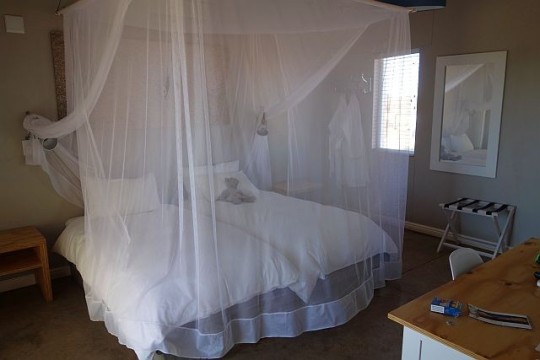





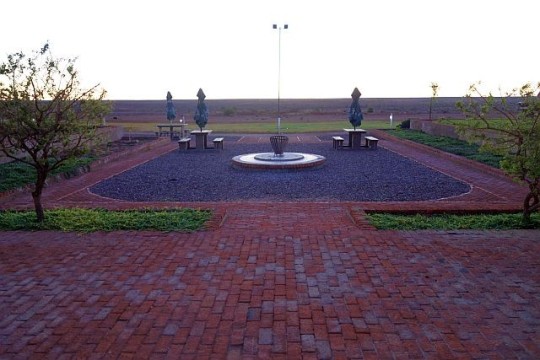

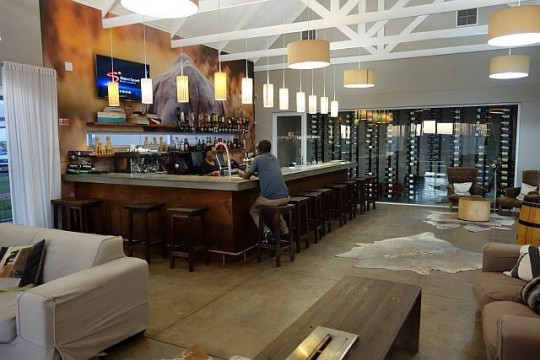


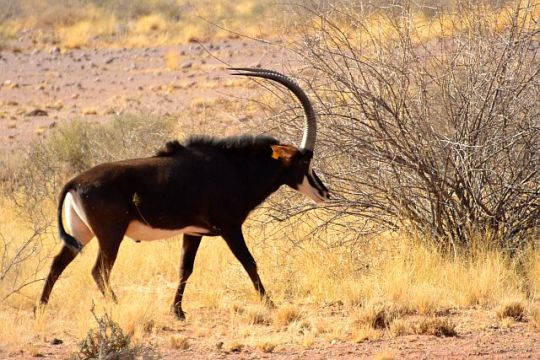

7 notes
·
View notes
Text
DISCOVER YOU ANIMAL PERSONALITY

-> YOU ARE A SABLE
SABLE CHARACTERISTICS: Protective • Eloquent • Charming • Snooty • Judgmental
SCIENTIFIC NAME: Hippotragus niger niger
COLLECTIVE TERM: A refinement of sable
DAPPER AND NOBLE
Cool and confident - if not a little over-polished - sables are the most graceful of the herbivore personalities. With their outstanding physical presence and successful work ethic, they enjoy the universal admiration from colleagues and friends. Dapper in dress and noble in bearing, their tastes and lifestyle are refined and restrained and they disapprove of flashy or ostentatious behavior in any form.
SABLES ARE SUPER-SLEEK
Attractive to the opposite sex and popular with their own, sables create a sense of well-being in those who surround them. There is a downside to this adulation, however, for the sable sometimes feels pressured into leadership roles that it has no desire to fill, and even though it's not known to be particularly soft-hearted it's the first person to help someone in need.
When life's obstacles are not sufficiently challenging sables set even higher personal goals and, with boundless energy, subject themselves to a vigorous regimen of biking, running, or hiking. Whether tooling around in a sports car or simply running on the beach, speed holds a special fascination, and sables love nothing more than the feel of wind in their hair.
SABLES IN THE WORKPLACE
In business, sables are admired for their excellent negotiation skills and their ability to make courageous decisions. Because of the ease of which they earn money, they tend to be profligate in their spending habits and don't hesitate to spend money on leisure activities.
Sables fiercely protect their hard earned reputation for integrity, taking pride in their ability to make business deals with just a handshake. They are cautious about bestowing that trust to others, however, which further aggravates their reputation for taking themselves too seriously.
Sables have a particular distaste for routine of any kind, and their work must always be demanding and fast paced. As a high-powered salesperson, stock-broker or manager they are consistently in the top echelons of their field and should avoid jobs that have little chance for advancement.
SABLES IN THE WILD
The sable is surely the most handsome of all the antelope. With long curving horns, these black-coated animals are so confident of their strength that they will even take on a lion in defense of their territories. When approaching a water hole, other grazing animals give way to families of up to thirty individual sable, but they are peaceful if left alone. The adult sable has no natural enemies except man.
Particularly magnificent is the giant sable of southern Africa. Although it is an extremely endangered animal, the majority of its population lives safely in the Luando Reserve in Angola.
CAREERS & HOBBIES
Financier • Stockbroker • Manager • CEO
Fast cars • Team sports • Fine art • Music
LOVE & FRIENDSHIP
The sable is a decidedly sexy partner. Educated and open-minded, it insists on variety in its lovemaking, which ranges from a long night of soft cuddling to a spontaneous over-the-kitchen-counter encounter. Sometimes its libido takes on a more quixotic aspect, involving adventurous fantasies and intricate scenarios.
Although the sable is a romantic, it will never be accused of being a syrupy sentimentalist. It showers its lover with compliments and praise, but always manages to keep a sincere tone to its flattery. The stable sable often chooses to live with its partner before committing to a life of monogamy, and by bringing all its worldly experience to the union, the marriage is almost certain to succeed.
When you're as attractive to the opposite sex as the sable is, it's often difficult to determine the true motives of a prospective suitor. Is it my good looks or my money that he or she is interested in? That’s why sables are picky when it comes to their love partners, and are quick to rebuff the advances of the lowly reptiles and annoying primates. While some would fault them for this brusque style of rejection, their up-front policy seems to cause less damage in the long run.
As a typical herbivore, the sable has a natural affinity for the strong willed horses and zebras. Their passionate and untamed spirits fill the sable with carnal arousal and their subsequent wild romps are the talk of the animal kingdom.
Tagged by: @thegreenxrcher
Tagging: @strategiic / @werise , @nerdybirdboy / @assortedsouls / @astralmedic , @rxsurrxcted , @manynarrators , @egyptiandeathgod , @brucene / @veratridine , @lcbotomy , @thedemonconstantine / @collidingxworlds , @theprinceof-gothamcity , @adsagsona
#》headcanons:dionisus#//nothing in all that's written here is wrong to be honest#//i snorted at the last paragraph though
4 notes
·
View notes
Text

Southern sable antelope Hippotragus niger niger
Observed by craigpeter, CC BY-NC
55 notes
·
View notes
Text
DISCOVER YOUR ANIMAL PERSONALITY !

Muse Jared: Merman verse
SABLE CHARACTERISTICS: Protective • Eloquent • Charming • Snooty • Judgmental SCIENTIFIC NAME: Hippotragus niger niger COLLECTIVE TERM: A refinement of sable
DAPPER AND NOBLE
Cool and confident - if not a little over-polished - sables are the most graceful of the herbivore personalities. With their outstanding physical presence and successful work ethic, they enjoy the universal admiration from colleagues and friends. Dapper in dress and noble in bearing, their tastes and lifestyle are refined and restrained and they disapprove of flashy or ostentatious behavior in any form.
SABLES ARE SUPER-SLEEK
Attractive to the opposite sex and popular with their own, sables create a sense of well-being in those who surround them. There is a downside to this adulation, however, for the sable sometimes feels pressured into leadership roles that it has no desire to fill, and even though it's not known to be particularly soft-hearted it's the first person to help someone in need.
When life's obstacles are not sufficiently challenging sables set even higher personal goals and, with boundless energy, subject themselves to a vigorous regimen of biking, running, or hiking. Whether tooling around in a sports car or simply running on the beach, speed holds a special fascination, and sables love nothing more than the feel of wind in their hair.
SABLES IN THE WORKPLACE
In business, sables are admired for their excellent negotiation skills and their ability to make courageous decisions. Because of the ease of which they earn money, they tend to be profligate in their spending habits and don't hesitate to spend money on leisure activities.
Sables fiercely protect their hard earned reputation for integrity, taking pride in their ability to make business deals with just a handshake. They are cautious about bestowing that trust to others, however, which further aggravates their reputation for taking themselves too seriously.
Sables have a particular distaste for routine of any kind, and their work must always be demanding and fast paced. As a high-powered salesperson, stock-broker or manager they are consistently in the top echelons of their field and should avoid jobs that have little chance for advancement.
SABLES IN THE WILD
The sable is surely the most handsome of all the antelope. With long curving horns, these black-coated animals are so confident of their strength that they will even take on a lion in defense of their territories. When approaching a water hole, other grazing animals give way to families of up to thirty individual sable, but they are peaceful if left alone. The adult sable has no natural enemies except man.
Particularly magnificent is the giant sable of southern Africa. Although it is an extremely endangered animal, the majority of its population lives safely in the Luando Reserve in Angola.
tagged by: @titanofthemoon
tagging: @thegreenxrcher, @blue-eyed-devils, @aandag, @nottobecrossed, @misfitxbeggars
4 notes
·
View notes
Text
Animal in you

YOU ARE A SABLE.
SABLE CHARACTERISTICS: Protective • Eloquent • Charming • Snooty • Judgmental
SCIENTIFIC NAME: Hippotragus niger niger
COLLECTIVE TERM: A refinement of sable
DAPPER AND NOBLE
Cool and confident - if not a little over-polished - sables are the most graceful of the herbivore personalities. With their outstanding physical presence and successful work ethic, they enjoy the universal admiration from colleagues and friends. Dapper in dress and noble in bearing, their tastes and lifestyle are refined and restrained and they disapprove of flashy or ostentatious behavior in any form.
SABLES ARE SUPER-SLEEK
Attractive to the opposite sex and popular with their own, sables create a sense of well-being in those who surround them. There is a downside to this adulation, however, for the sable sometimes feels pressured into leadership roles that it has no desire to fill, and even though it's not known to be particularly soft-hearted it's the first person to help someone in need.
When life's obstacles are not sufficiently challenging sables set even higher personal goals and, with boundless energy, subject themselves to a vigorous regimen of biking, running, or hiking. Whether tooling around in a sports car or simply running on the beach, speed holds a special fascination, and sables love nothing more than the feel of wind in their hair.
SABLES IN THE WORKPLACE
In business, sables are admired for their excellent negotiation skills and their ability to make courageous decisions. Because of the ease of which they earn money, they tend to be profligate in their spending habits and don't hesitate to spend money on leisure activities.
Sables fiercely protect their hard earned reputation for integrity, taking pride in their ability to make business deals with just a handshake. They are cautious about bestowing that trust to others, however, which further aggravates their reputation for taking themselves too seriously.
Sables have a particular distaste for routine of any kind, and their work must always be demanding and fast paced. As a high-powered salesperson, stock-broker or manager they are consistently in the top echelons of their field and should avoid jobs that have little chance for advancement.
SABLES IN THE WILD
The sable is surely the most handsome of all the antelope. With long curving horns, these black-coated animals are so confident of their strength that they will even take on a lion in defense of their territories. When approaching a water hole, other grazing animals give way to families of up to thirty individual sable, but they are peaceful if left alone. The adult sable has no natural enemies except man.
Particularly magnificent is the giant sable of southern Africa. Although it is an extremely endangered animal, the majority of its population lives safely in the Luando Reserve in Angola.
Tagged by: S t o l e n :3
#( dash games. )#Muse; Rhoda#( It's ... kinda spot on. )#( I mean. When you look at it different x3 )
3 notes
·
View notes
Text
What Animal Are You?

Cool and confident - if not a little over-polished - sables are the most graceful of the herbivore personalities. With their outstanding physical presence and successful work ethic, they enjoy the universal admiration from colleagues and friends. Dapper in dress and noble in bearing, their tastes and lifestyle are refined and restrained and they disapprove of flashy or ostentatious behavior in any form.
Sables are Super-sleek
Attractive to the opposite sex and popular with their own, sables create a sense of well-being in those who surround them. There is a downside to this adulation however, for the sable sometimes feels pressured into leadership roles that it has no desire to fill, and even though it's not known to be particularly soft-hearted it's the first person to help someone in need.
When life's obstacles are not sufficiently challenging sables set even higher personal goals and, with boundless energy, subject themselves to a vigorous regimen of biking, running, or hiking. Whether tooling around in a sports car or simply running on the beach, speed holds a special fascination, and sables love nothing more than the feel of wind in their hair.
Sables in the Workplace
In business, sables are admired for their excellent negotiation skills and their ability to make courageous decisions. Because of the ease of which they earn money, they tend to be profligate in their spending habits and don't hesitate to spend money on leisure activities.
Sables fiercely protect their hard earned reputation for integrity, taking pride in their ability to make business deals with just a handshake. They are cautious about giving that trust to others, however, which further aggravates their reputation for taking themselves too seriously.
Sables have a particular distaste for routine of any kind, and their work must always be demanding and fast paced. As a high-powered salesperson, stock-broker or manager they are consistently in the top echelons of their field and should avoid jobs that have little chance for advancement.
Sables in the Wild
The sable is surely the most handsome of all the antelope. With long curving horns, these black-coated animals are so confident of their strength that they will even take on a lion in defense of their territories. When approaching a water hole, other grazing animals give way to families of up to thirty individual sable, but they are peaceful if left alone. The adult sable has no natural enemies except man.
Particularly magnificent is the giant sable of southern Africa. Although it is an extremely endangered animal, the majority of its population lives safely in the Luando Reserve in Angola.
Careers & Hobbies
Financier
Stockbroker
Manager
CEO
Fast cars
Team sports
Fine art
Music
Love & Friendship
The sable is a decidedly sexy partner. Educated and open-minded, it insists on variety in its lovemaking, which ranges from a long night of soft cuddling to a spontaneous over-the-kitchen-counter encounter. Sometimes its libido takes on a more quixotic aspect, involving adventurous fantasies and intricate scenarios.
Although the sable is a romantic, it will never be accused of being a syrupy sentimentalist. It showers its lover with compliments and praise, but always manages to keep a sincere tone to its flattery. The stable sable often chooses to live with its partner before committing to a life of monogamy, and by bringing all its worldly experience to the union, the marriage is almost certain to succeed.
When you're as attractive to the opposite sex as the sable is, it's often difficult to determine the true motives of a prospective suitor. Is it my good looks or my money that he or she is interested in? So sables are picky when it comes to their love partners, and are quick to rebuff the advances of the lowly reptiles and annoying primates. While some would fault them for this brusque style of rejection, their up-front policy seems to cause less damage in the long run.
As a typical herbivore, the sable has a natural affinity for the strong willed horses and zebras. Their passionate and untamed spirits fill the sable with carnal arousal and their subsequent wild romps are the talk of the animal kingdom.
Tagged by: @oneuglyturian
Tagging: TAKE IT there’s so few questions I love this
#[ OH MY /GOD/. THEY'RE THE /SAME/. ]#( out of ancestor's light. )#( tagging games. )#( neoma means night. ) headcanons.
4 notes
·
View notes
Text
Trips of a Lifetime

Cruise Western Africa in Senegal and the Gambia
Tour the lesser-known part of the African continent with Peregrine’s eight-day Cruising the Rivers of West Africa tour. You’ll see wildlife like dolphins, crocodiles, manatees, and more while aboard the company’s small cruise ship. Then you’ll head inland for a visit to The Gambia National Park to see chimpanzees and make a humbling stop at the island of Kunteh Kinteh, where the American slave trade began. lead with reason A new airport in Dakar makes travel even more accessible this year.
RELATED:
9 Affordable Dream Vacations to Take in 2019
Witness the Great Elephant Migration
For another amazing wildlife experience, book Wilderness Travel’s new trip, The Great Elephant Migration. This 11-day tour takes you through Botswana, Zimbabwe, and Victoria Falls. It’s timed with the elephant migration (July and August departures only) that takes place in Hwange National Park. You’ll also have the opportunity to find leopards, lions, spotted hyenas, jackals, giraffes, buffalo, antelope, and sable, and even participate in night drives for some nocturnal animal sightings. Accommodations include luxurious camps like Camp Kuzuma and Zambezi Sands.
Asia
Be a Nomad in Mongolia
Experience nomadic life in Mongolia on G Adventures’ 10-day tour through the northern part of the country. You’ll ride horseback through the countryside and stay overnight in a homestay at a nomadic camp where you get to sleep in a ger(similar to a yurt). Visit Mongolia now while it’s still a relatively untouched tourist destination; the government recently said it wants to increase tourist visits to 1 million per year in 2020.
Trek the Hidden Himalayas
Head to Dolpo, a part of the Himalayas that’s only accessible by foot. Wilderness Travel’s 13-day trek takes you to the untouched trails and villages of this part of Nepal as you see how ancient Tibetans lived (this part of the region is culturally Tibetan). Highlights include Phoksundo Lake, Kathmandu’s temples, and of course plenty of mani (prayer) walls and chortens (shrines).
RELATED:
Bhutan for Beginners: A First-Time Trekker Tackles the Famed Druk Path
View Japan in a Different Light
Many visitors flock to Japan’s tourist hot spots in spring (to see cherry blossoms) or fall (to enjoy the vivid foliage), and with the country drawing increased attention thanks to the upcoming 2020 Olympics, these times of year are even more crowded. Instead, opt for something different and take a tour of Japan in winter with Topdeck’s seven-day Japan Winter tour. You’ll get the chance to ski at the country’s famed resorts, visit a historical theme park, enjoy sulfuric hot springs, and take a city tour of less-touristy Sapporo.
Central America
See a Different Side of Mexico Than You Did on Spring Break
Mexico’s heartlands are literally the heart and soul of authentic Mexican culture. While the coastal beaches are breathtaking, opt for a more immersive experience on Intrepid’s 15-day tour throughout central Mexico. You’ll visit a pueblo magico, explore the trendy city of San Miguel de Allende, taste tequila in Guadalajara, take a walking tour of Mexico City, and see the Pyramid of the Sun in Teotihuacan up close.
RELATED:
Pueblos Magicos: 10 Secret Mexican Villages
North Africa/Middle East
Explore Undiscovered Oman
SmarterTravel named Oman an emerging destination two years ago, and the country is starting to see more visitors for its blend of culture, beaches, and natural landscapes. G Adventures offers an eight-day tour that takes you through highlights like the Wadi Kakar (Oman’s version of the Grand Canyon), desert camping in the Wahiba Sands, a visit to a turtle reserve, and a tour of the capital, Muscat.
Oceania
Discover Australia Without Going to Sydney
While Sydney is an amazing part of Australia, there’s so much more to the country than just its East Coast. G Adventures’ affordable North to South trip includes the unspoiled national parks in the Northern Territory and makes overnight stops in the Outback at Alice Springs and Uluru before heading down to South Australia’s urban hot spot, Adelaide. Most of the accommodations on this budget-conscious trip are basic, but they include experiences like camping in the Outback and sleeping underground in an opal-mining town.
Europe
Eat (and Hike) Your Way Through Italy’s Boot
If you’re an Anthony Bourdain fan, you may remember the season 10 finale that aired in late 2017, Southern Italy: The Heel of the Boot, which has inspired travelers to get off the beaten path in Italy ever since. Wilderness Travel’s new tour this year, Hiking Puglia and Calabria, visit some of the same mystical towns Bourdain did in what’s sure to be the next popular tourist spot in Italy. Activities range from culinary experiences like wine and olive oil tastings to excursions like cliffside hiking and cave exploring. You’ll also see two UNESCO World Heritage sites: the cave dwellings of Matera (also a European Capital of Culture this year) and the famed Trulli houses in Alberobello.
Float Down the Danube on a Reinvented River Cruise
A river cruise is one of the best ways to see Europe, and U by Uniworld is shaking things up for the industry. With ships and itineraries designed for the “young at heart,” this isn’t your grandparents’ river cruise. My pick for 2019 is the Danube Flow cruise, which covers three countries in eight days: Germany, Austria, and Hungary. There are also departure dates with special itineraries that overlap with Oktoberfest, Sziget Festival, and the holiday Christmas markets and New Year’s Eve celebrations.
RELATED:
The 10 Best Solo Vacations for 2019
Walk England Coast to Coast
Sleep in cozy countryside inns while you cross England by walking 192 miles over nine days. REI Adventures’ England Coast to Coast Hiking trip takes you through three national parks: Lake District, Yorkshire Dales, and North York Moors, where you’ll see grazing sheep, storybook villages, and stunning landscapes. Along the way, you rest at local pubs and teahouses, and the tour includes stops at the home of William Wordsworth, Richmond Castle, Easby Abbey, and more.
Bike the Causeway Coast
The adventurous and active can take a weeklong, self-guided tour through Northern Ireland. Viator’s Causeway Coast Cycle Self-Guided tour is ideal for travelers who want to go at it alone but need some help planning. The itinerary starts with a city cycle tour in Belfast, where you’ll explore iconic sights. You then bike along the coastline with stops in villages and castles to rest and sleep at small inns. The tour includes a ferry ride to Rathlin Island, Giant’s Causeway, Carrick-a-Rede Rope Bridge, Bushmills Whiskey Distillery, an optional trip to the Dark Hedges, and return transportation to Dublin.
Explore Portuguese and Spanish Islands You’ve Never Heard Of
Portugal was 2018’s hottest destination, and tourism growth shows no signs of slowing down in 2019. Avoid the overcrowded spots with a 15-day cruise throughout the Portuguese and Spanish islands. Hurtigruten’s Atlantic Exploration itinerary is new this year and covers the Azores, Madeira, and the Canary Islands. The journey begins and ends in Lisbon, so you’ll have plenty of time to explore the capital. Stops include three areas of the volcanic archipelago—the Green Island (Sao Miguel), the Blue Island (Ilha Azul or Faial), and the Purple Island (Angra), as well the islands of Porto Santo and Madeira of Portugal, and two islands in the Canaries: Santa Cruz de Tenerife and the less-visited San Sebastian de la Gomera.
North America
Visit a Rainforest in Canada
Home to fjords, rare wildlife, and, yes, a rainforest, is Canada’s British Columbia province. Maple Leaf Adventures’ Great Bear Rainforest trips are sailing-based and include tons of wildlife excursions with opportunities to see grizzly bears, spirit bears, black bears, baleen whales, orcas, gray wolves, and bald eagles. The itinerary also includes cultural experiences with First Nation villages, a trip to hot springs, and kayaking.
RELATED:
Canada Forever: The Ultimate Canada Holiday for Every Month
Go on a Snow-for Adventure
If you’re into snow sports, then this trip should be on your bucket list. Topdeck’s 10-day Great White North tour takes you to Whistler, Big White, and the Big Three ski resorts in Banff. You’ll also experience some of Canada’s epic drives and sights, like the Sea to Sky Highway, Fraser Valley, the Coquihalla Pass, Kicking Horse Pass, and the Continental Divide.
South America
Tour Chilean Wine Country
Chile is a hot destination in 2019 with Patagonia’s popularity and the 2019 solar eclipse, but you should visit this destination for another reason: the Casablanca Valley. The area is known for its Chardonnay, Sauvignon Blanc, and Pinot Noir, but has distinct microclimates that growers are learning more about to produce other varieties, like Malbec and Merlot. This trip of a lifetime is just 90 minutes from Santiago by car. Use Upscale travel to plan your perfect trip through the region; activities can include cycling, a helicopter ride, dining with winemakers, and more.
RELATED:
5 Secret Wine Regions You’ve Probably Never Heard Of
Backpack Through Bolivia
Bolivia’s salt flats are otherworldly, and the country as a whole is on its way to becoming the next South American hot spot. Contiki’s 13-day Bella Bolivia tour covers tons of ground, starting in La Paz, the capital, and ending in Chile’s Santiago—the first nine days are spent in Bolivia with an included flight to Santiago on day 11. You’ll truly see it all: the cathedrals of La Paz, the Witches’ Market, the white stone buildings in Sucre, Salar de Uyuni (salt flats), Avaroa National Reserve, the Salvador Dali desert, and plenty more to make this trip of life worthwhile.
Go to the Remote Falkland Islands
Getting to these remote and almost-polar islands isn’t easy—or cheap—but this year marks the first new flight route to the U.K. territory since the late ‘90s. Though no date has been set, the flights will go from Argentina to the islands with LATAM Airlines. Intrepid is offering a new-to-2019 tour for eight days, Falkland Island Expedition: Past & Present, which will take you to beaches, nature reserves, and the battlegrounds from the war of 1982. And don’t forget about the wildlife; a king, Magellanic, and gentoo penguins all call this place home.
Polar
Spend a Night on a Glacier in the Arctic Fjords
If Norway’s Arctic fjords are on your bucket list, take your vacation to the next level with a trip to Svalbard. Off the Map Travel’s summer trip to the archipelago includes dog sledding, kayaking, a glacier climb, and the once-in-a-lifetime chance to sleep on a glacier at the Nordenskiold Lodge. Note that you won’t see the northern lights this time of year, but rather experience the “land of the midnight sun,” which also happens to give you the best chance to see polar bears. If you’re looking for a northern lights experience, the tour company has a four-day All Day Aurora tour to the same region.
1 note
·
View note
Text
animal personality !
Tagged: stole it from myself
Tagging: steal it

Average to large size
Protective
Eloquent
Charming
Snooty
Judgemental
Cool and confident - if not a little over-polished - sables are the most graceful of the herbivore personalities. With their outstanding physical presence and successful work ethic, they enjoy the universal admiration from colleagues and friends. Dapper in dress and noble in bearing, their tastes and lifestyle are refined and restrained and they disapprove of flashy or ostentatious behavior in any form.
Sables are Super-sleek
Attractive to the opposite sex and popular with their own, sables create a sense of well-being in those who surround them. There is a downside to this adulation however, for the sable sometimes feels pressured into leadership roles that it has no desire to fill, and even though it's not known to be particularly soft-hearted it's the first person to help someone in need.
When life's obstacles are not sufficiently challenging sables set even higher personal goals and, with boundless energy, subject themselves to a vigorous regimen of biking, running, or hiking. Whether tooling around in a sports car or simply running on the beach, speed holds a special fascination, and sables love nothing more than the feel of wind in their hair.
Sables in the Workplace
In business, sables are admired for their excellent negotiation skills and their ability to make courageous decisions. Because of the ease of which they earn money, they tend to be profligate in their spending habits and don't hesitate to spend money on leisure activities.
Sables fiercely protect their hard earned reputation for integrity, taking pride in their ability to make business deals with just a handshake. They are cautious about giving that trust to others, however, which further aggravates their reputation for taking themselves too seriously.
Sables have a particular distaste for routine of any kind, and their work must always be demanding and fast paced. As a high-powered salesperson, stock-broker or manager they are consistently in the top echelons of their field and should avoid jobs that have little chance for advancement.
Sables in the Wild
The sable is surely the most handsome of all the antelope. With long curving horns, these black-coated animals are so confident of their strength that they will even take on a lion in defense of their territories. When approaching a water hole, other grazing animals give way to families of up to thirty individual sable, but they are peaceful if left alone. The adult sable has no natural enemies except man.
Particularly magnificent is the giant sable of southern Africa. Although it is an extremely endangered animal, the majority of its population lives safely in the Luando Reserve in Angola.
Careers & Hobbies
Financier
Stockbroker
Manager
CEO
Fast cars
Team sports
Fine art
Music
Love & Friendship
The sable is a decidedly sexy partner. Educated and open-minded, it insists on variety in its lovemaking, which ranges from a long night of soft cuddling to a spontaneous over-the-kitchen-counter encounter. Sometimes its libido takes on a more quixotic aspect, involving adventurous fantasies and intricate scenarios.
Although the sable is a romantic, it will never be accused of being a syrupy sentimentalist. It showers its lover with compliments and praise, but always manages to keep a sincere tone to its flattery. The stable sable often chooses to live with its partner before committing to a life of monogamy, and by bringing all its worldly experience to the union, the marriage is almost certain to succeed.
When you're as attractive to the opposite sex as the sable is, it's often difficult to determine the true motives of a prospective suitor. Is it my good looks or my money that he or she is interested in? So sables are picky when it comes to their love partners, and are quick to rebuff the advances of the lowly reptiles and annoying primates. While some would fault them for this brusque style of rejection, their up-front policy seems to cause less damage in the long run.
As a typical herbivore, the sable has a natural affinity for the strong willed horses and zebras. Their passionate and untamed spirits fill the sable with carnal arousal and their subsequent wild romps are the talk of the animal kingdom.
1 note
·
View note
Text
which animal is your muse?
Tagged by: @willreignite
Tagging: Anyone who wants to? @worldwearyjedi @errantson @luminousxbeings
Cool and confident - if not a little over-polished - sables are the most graceful of the herbivore personalities. With their outstanding physical presence and successful work ethic, they enjoy the universal admiration from colleagues and friends. Dapper in dress and noble in bearing, their tastes and lifestyle are refined and restrained and they disapprove of flashy or ostentatious behavior in any form.
Sables are Super-sleek
Attractive to the opposite sex and popular with their own, sables create a sense of well-being in those who surround them. There is a downside to this adulation however, for the sable sometimes feels pressured into leadership roles that it has no desire to fill, and even though it's not known to be particularly soft-hearted it's the first person to help someone in need.
When life's obstacles are not sufficiently challenging sables set even higher personal goals and, with boundless energy, subject themselves to a vigorous regimen of biking, running, or hiking. Whether tooling around in a sports car or simply running on the beach, speed holds a special fascination, and sables love nothing more than the feel of wind in their hair.
Sables in the Workplace
In business, sables are admired for their excellent negotiation skills and their ability to make courageous decisions. Because of the ease of which they earn money, they tend to be profligate in their spending habits and don't hesitate to spend money on leisure activities.
Sables fiercely protect their hard earned reputation for integrity, taking pride in their ability to make business deals with just a handshake. They are cautious about giving that trust to others, however, which further aggravates their reputation for taking themselves too seriously.
Sables have a particular distaste for routine of any kind, and their work must always be demanding and fast paced. As a high-powered salesperson, stock-broker or manager they are consistently in the top echelons of their field and should avoid jobs that have little chance for advancement.
Sables in the Wild
The sable is surely the most handsome of all the antelope. With long curving horns, these black-coated animals are so confident of their strength that they will even take on a lion in defense of their territories. When approaching a water hole, other grazing animals give way to families of up to thirty individual sable, but they are peaceful if left alone. The adult sable has no natural enemies except man.
Particularly magnificent is the giant sable of southern Africa. Although it is an extremely endangered animal, the majority of its population lives safely in the Luando Reserve in Angola.
Love & Friendship
The sable is a decidedly sexy partner. Educated and open-minded, it insists on variety in its lovemaking, which ranges from a long night of soft cuddling to a spontaneous over-the-kitchen-counter encounter. Sometimes its libido takes on a more quixotic aspect, involving adventurous fantasies and intricate scenarios.
Although the sable is a romantic, it will never be accused of being a syrupy sentimentalist. It showers its lover with compliments and praise, but always manages to keep a sincere tone to its flattery. The stable sable often chooses to live with its partner before committing to a life of monogamy, and by bringing all its worldly experience to the union, the marriage is almost certain to succeed.
When you're as attractive to the opposite sex as the sable is, it's often difficult to determine the true motives of a prospective suitor. Is it my good looks or my money that he or she is interested in? So sables are picky when it comes to their love partners, and are quick to rebuff the advances of the lowly reptiles and annoying primates. While some would fault them for this brusque style of rejection, their up-front policy seems to cause less damage in the long run.
Their passionate and untamed spirits fill the sable with carnal arousal and their subsequent wild romps are the talk of the animal kingdom.
1 note
·
View note